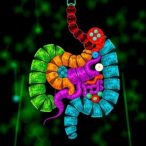![CATZ study showed adding zonisamide to existing medications reduced frequency of seizures in children aged 6-17 years.[© ktsdesign - Fotolia.com]](https://www.genengnews.com/wp-content/uploads/2018/08/Aug31_2011_7427959_BrainwithLightning_PosResultsEisaiPediatricEpilepsyDrug2437321111.jpg)
Credit: © ktsdesign / Fotolia.com
Citrate is a metabolite essential to the metabolism and development of neurons. A membrane transport protein called SLC13A5 plays a central role in this process and has previously been linked to a particularly severe form of epileptic encephalopathy. Building on data from the recently completed RESOLUTE and REsolution flagship projects, scientists headed by Giulio Superti-Furga, PhD, scientific director at CeMM Research Center for Molecular Medicine of the Austrian Academy of Sciences, comprehensively studied the function and structure of the membrane transporter SLC13A5, experimentally investigating 38 mutant variants.
Their findings, published in Science Advances (“Large-scale experimental assessment of variant effects on the structure and function of the citrate transporter SLC13A5,”) shed new light on the mechanisms of this disease and lay the foundation for further research into epilepsy and other disorders.
In their report, senior author Superti-Furga and colleagues suggest that the collection of variant effects resulting from their work could provide, “a valuable platform for further detailed analyses of specific variants, as well as for the development of therapeutics.” The scientists were supported by the REsolution consortium, the successor to RESOLUTE—a large-scale project led by Superti-Furga at CeMM that functionally mapped the entire SLC transporter family and helped decode the “logistics of the cell.”
Citrate, the negatively charged ion of citric acid, is a key component in the metabolism of every cell. In the citric acid cycle—often referred to as the “hub” of cellular metabolism—organic substances are broken down to generate chemical energy, while also producing various precursors for the biosynthesis of fatty acids and critical signaling molecules involved in inflammation and cell development. “Citrate regulates allosterically the balance between glycolysis and the synthesis of fatty acids and is a precursor of several metabolites that participate in signaling and cellular regulation,” the team commented.
Citrate plays an especially important role in neurons. As a neuromodulator it influences neuronal activity and is therefore present in relatively high concentrations in the cerebrospinal fluid. Accordingly, neurons express high levels of the SLC13A5 transporter to facilitate citrate uptake. SLC13A5 regulates extracellular as well as intracellular citrate concentrations by importing it into the cytoplasm, the investigators explained further.
The regulation of extra versus intracellular citrate appears to be critical to neurons, the team further noted. When the SLC13A5 transporter is not fully functional it can lead to SLC13A5 citrate transporter disorder—a severe form of epilepsy associated with impaired brain development (referred to as developmental epileptic encephalopathy, DEE). This condition is caused by mutations in the SLC13A5 gene. However, until now, little was known about which mutations are involved, how they affect the molecular function of the transporter, and how they influence disease progression. “Understanding the effect of genetic variants on SLC13A5 structure and function is essential to understand citrate biology and to help diagnose patients with SLC13A5 citrate transporter disorder from genomic data,” the authors stated.
To address this knowledge gap, the team carried out deep mutational scanning (DMS)—analyzing the effect of nearly ten thousand different genetic mutations on the function of the SLC13A5 transport protein. The researchers noted that this approach can, “… in a large-scale manner, directly link variants to their effect on the protein.” Their dataset was further enriched by computational analyses of protein stability, and 38 mutated SLC13A5 variants were selected for experimental investigation. “We selected 38 variants for experimental validation and for testing several mechanisms of pathogenicity associated with gene expression, intracellular trafficking, subcellular localization, and citrate transport,” they wrote. These variants included 16 mutations observed in patients.
Their study revealed several molecular mechanisms linked to manifestation of the disease. These included differences in transporter production levels in neurons, their precise localization in the cell membrane, and the actual rate of citrate transport. “Overall, through our validation experiments, we provided evidence that all patient variants were unable to import citrate into the cell and identified six previously unknown loss-of-function variants,” the scientists reported.
“With these results, we were able to identify and characterize disease-causing variants of the SLC13A5 transporter,” further commented first author Wen-An Wang, PhD, summarizing the main findings of the study. “In addition, by computationally analyzing the mutant variants, we assessed protein stability across different conformations and established an evolutionary conservation score for all variants,” added co-first author Evandro Ferrada, PhD, who is now at the University of Valparaíso in Chile.
“Our work highlights the importance of systematically investigating the effects of genetic variant,” Superti-Furga noted. “Especially in rare diseases such as SLC13A5 citrate transporter deficiency, a specific form of epilepsy, this approach helps us uncover molecular disease mechanisms. At the same time, we gain valuable insights into the impact of variants that also occur in the general population—an important step toward a more comprehensive understanding of genetic diversity and its impact on human health.”
In their paper the authors suggested that their collective results “… illustrate an unbiased mutational landscape of the citrate transporter, illuminate mechanisms of pathogenicity, and offer a platform for the analysis of specific variants as well as opportunities for the future development of intervention strategies.”



